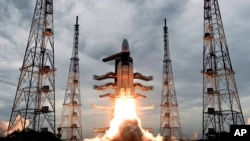India's ambitious mission to land an unmanned probe on the moon suffered a setback when its space agency lost contact with the landing craft minutes before it was to make a critical touchdown on the lunar surface.
It was a disappointment for a country that had hoped to successfully demonstrate a feat achieved by only three other countries so far — the United States, the former Soviet Union and China.
Millions in the country stayed awake to watch live images of the "soft landing" that was to place a lander on the unexplored south pole of the moon around 2 a.m. local time Saturday. It was the most challenging component of India's second moon mission, Chandrayaan-2.
All appeared to be on track, but the mood in the mission control room changed in the final moments when the lander was about 2 kilometers away from the lunar surface.
"The Vikram lander descent was (ongoing) as planned and normal performance was observed," chairman of India's Space Research, Organization, K. Sivan, said in a brief announcement. "Subsequently, communication from lander to the ground stations was lost. Data is being analyzed."
Prime Minister Narendra Modi who had been monitoring the landing with space scientists at the mission control room in Bengaluru, lauded their efforts. "Ups and downs keep coming in life. Your hard work has taught us a lot and the entire country is proud of you," he added.
He later tweeted, "India is proud of our scientists! They've given their best and have always made India proud. These are moments to be courageous and courageous we will be."
With contact lost, it is not clear if the vehicle landed safely on the lunar surface or not.
'15 minutes of terror'
Landing on the lunar surface is a complex maneuver fraught with challenges and had earlier been described by ISRO head Sivan as "15 minutes of terror." It involves reducing the velocity at which the lander comes down to ensure a touchdown so soft that it prevents damage, tilting or crashing. Only about half the 38 attempts to land on the moon have been successful.
India had hoped that mastering technology for soft landing would provide critical building blocks to mount further missions to Mars and other planets.
"Suppose you want to land something on Mars or do some docking activity, this knowledge is very critical," Mukund Rao, an expert in space technology, said. "If you just orbit around say the Mars and moon, it does not give you the capability of landing and colonizing and doing some exploitation."
Indian scientists said the roughly $140 million mission was meant to study the south pole because a larger area there remains in shadow, increasing the possibility of water and making it a likely target for moon habitation.
There has been massive renewed interest in exploring the moon in recent years. China landed a craft earlier this year and the U.S. space agency has plans to put astronauts on the moon by 2024.
Chandrayaan-2 was a huge step up from India's previous space explorations, such as its first moon mission in 2008 and a mission to Mars in 2013 that involved sending a spacecraft to the Red Planet.
There had been a massive groundswell of national pride in the mission. In the hours before the landing, television anchors had called it "historic" and "epochal," and schoolchildren across the country cheered it enthusiastically. Some students had been invited to watch the soft landing attempt with the prime minister.
India has a smaller space program compared to countries like the United States and and trails its Asian rival China, but it is mounting more ambitious programs hoping to get into the league of major space faring nations.
Prime Minister Modi is supportive of more space missions analysts say the nationalist leader sees them as a symbol to underline the country's rising stature. Planning is already underway for a manned mission to space by 2022, and robotic probes to Mars and Venus over the next decade.







